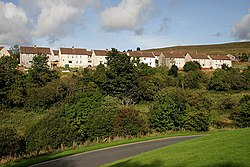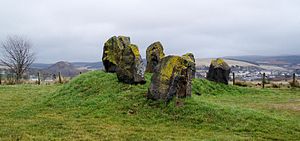Dalmellington
| Dalmellington Scots: Dawmellinton | |
| Ayrshire | |
|---|---|

| |
| Location | |
| Grid reference: | NS4764805958 |
| Location: | 55°19’26"N, 4°23’49"W |
| Data | |
| Post town: | Ayr |
| Postcode: | KA6 |
| Dialling code: | 01292 |
| Local Government | |
| Council: | East Ayrshire |
| Parliamentary constituency: |
Ayr, Carrick and Cumnock |
Dalmellington is a market town in Ayrshire. In 2001 the village had a population of 1,407.
The town may owe its origin to its position on the geological faultline separating the Southern Uplands from the Central Lowlands, as Dalmellington sits at the issue of a river from the uplands into Dalmellington Moss plain, and geology has in past ages blessed it with accessible coal also.
The town has a history as a rest area, market town, weaving centre and mining village. The Chalmeston open cast coal mine to the north of the village covered some 1,834 acres, but the operations have now ceased and the first phase of the site restoration has been completed.
Robert Hetrick the blacksmith-poet lived in the town in the 19th century.
There are many Sites of Special Scientific Interest around Dalmellington, the most notable being the nearby Loch Doon. The Scottish Dark Sky Observatory is located near Dalmellington and is within the northern edge of the Galloway Forest's Dark Sky Park.
History
Traces of Neolithic men have been found here: cairns and a few scraps of tools, and traces of early human activity around Loch Doon. There may have been crannogs at Bogton Loch and Loch Doon.
In the Middle Ages, Dalmellington was part of Kyle Stewart and under the rule of a series of Norman lords. It was during this period that "The Dalmellington Motte" was constructed.[1]
Events from the past have underlined Dalmellington's geographical importance, it is believed that the Doon Valley was a Roman thoroughfare and even possibly a Roman military station. During the time of the Covenanters 900 soldiers were stationed in the vicinity. There were two castles in the area, Loch Doon and Laight Alpin.
Eighteenth century Dalmellington was a small rural village with some 500 inhabitants, but the modern way of life was already taking shape. Good quality coal was being produced from surface workings and sent down the turnpike road to Galloway. The town grew after Watt`s engine had made deeper mine workings feasible, and the completion of the railway in 1858.

The Standing Stones of Dalmellington are a memorial erected in 1999 to the 7 mining villages of the Doon Valley.
Apart from the coal mining, there were 8,000 sheep and 800 black cattle on the hills, and plans were afoot for the spinning and weaving of wool. These plans resulted in 2 woollen mills which flourished for a time in the following century. The 2 mills employed about 30 people between them. The yarn from the largest was disposed of wholly to the Kilmarnock carpet manufacturers until the proprietor of the mill added a carpet manufactory with 8 looms constantly at work. The yarn spun in the second mill was also manufactured on the spot, into blankets, into plaid, packing cloth, etc.
There were also about 40 weavers working from home. Although by the 20th Century mining was the dominant industry, workers had to travel to outlying areas. Eight pits producing around 124,000 tons a year were operating in the 1940s. With the decline of the labour-intensive deep mining, the area is now dependent on its replacement - opencast mining.
Dalmellington Band
Dalmellington Band based in the village is one of Scotland's oldest brass bands and has been in the forefront of the movement since its formation in 1864. The band regularly provides music for: concerts, gala days, weddings, church services, opening days, parades, background music and Christmas events.
Sport
- Curling: Dalmellington Craigengillan Curling Club
- Junior football: Craigmark Burntonians FC
The Dalmellington Craigengillan Curling Club is the oldest constituted club in Dalmellington, formed on 3 December 1841 in the Black Bull Hotel and has continued unbroken since. In 2004 the members reinstated the outside curling pond at Craigengillan, this is the only self-leveling curling pond in Britain.
Outside links
| ("Wikimedia Commons" has material about Dalmellington) |
- Dalmellington Band
- Dalmellington.net
- Dalmellington fancy dress parade (c.1927) (archive film from the Scottish Screen Archive)
References
- ↑ [http://www.dalmellington.net/vpage.asp?s=4&p=30 Dalmellington.net
- Moore, John. Gently Flows the Doon. A guide to the Dalmellington, Patna and Loch Doon Area (1972) Pub. Dalmellington District Council, ISBN 0-9502841-0-6
- Reid, Donald L. Old Dalmellington, Patna & Waterside (2001) Pub. Stenlake of Catrine, ISBN 1-84033-149-6
- Reid, Donald L. Doon Valley Memories - Dalmellington, Dunaskin, Patna & District (2002) Pub Donald L Reid - ISBN 0-9522720-8-3
- Reid, Donald L. Doon Valley Bygones. A Pictorial Journey Down Memory Lane (2004)Pub. Donald L Reid, ISBN 0-9522720-3-2
- Reid, Donald L, Robert Burns' Valley of Doon (2005) Pub. Donald L Reid, ISBN 0-9522720-2-4
- Reid, Donald L, Discovering Matthew Anderson - Policeman Poet of Ayrshire (2009), (Pub Donald L Reid) ISBN 0-9522720-9-1
